Let’s welcome two venomous adversaries; the cottonmouth vs. copperhead snake. This animal showdown will be a slithering, fang-filled fight where anything could happen! Both species know how to go on the offensive, and one has a reputation for dining on smaller snakes.
Get ready for an adrenaline-fueled drama battle between the Cottonmouth and copperhead. Who will win in this serpent spectacle? Let’s find out now!
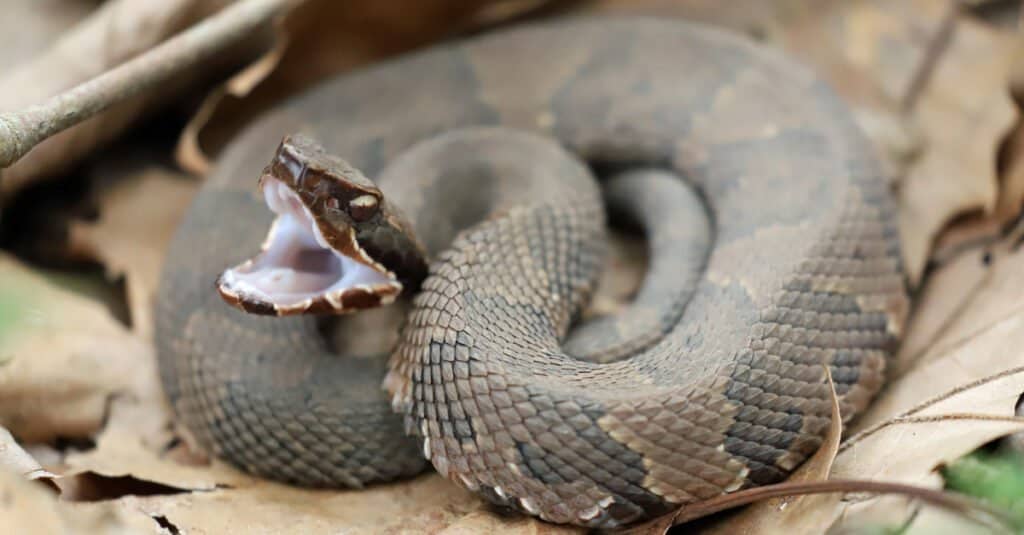
Cottonmouths show aggression by opening their mouths wide.
©KF2017/Shutterstock.com
Competitor Number One: The Cottonmouth
The cottonmouth, also known as the water moccasin, possesses distinct markings. Their coloration varies in green, brown, and black shades. These snakes also have an unmistakable dark contrasting dark line that runs through their eye.
Another notable feature is the cottonmouth’s unique spade-shaped head. The head stands out, emphasizing its larger size and thickness than its neck. And their cream-colored chin makes them even more recognizable.
These snakes’ wetland environment is marshy, with soft and moist ground sometimes covered in water. The air carries a sense of humidity, creating a sticky or damp feeling. These wetlands are biodiverse, teeming with various plant and animal species. This means there’s always plenty of food to fill the cottonmouth’s belly.
Competitor Number Two: The Copperhead
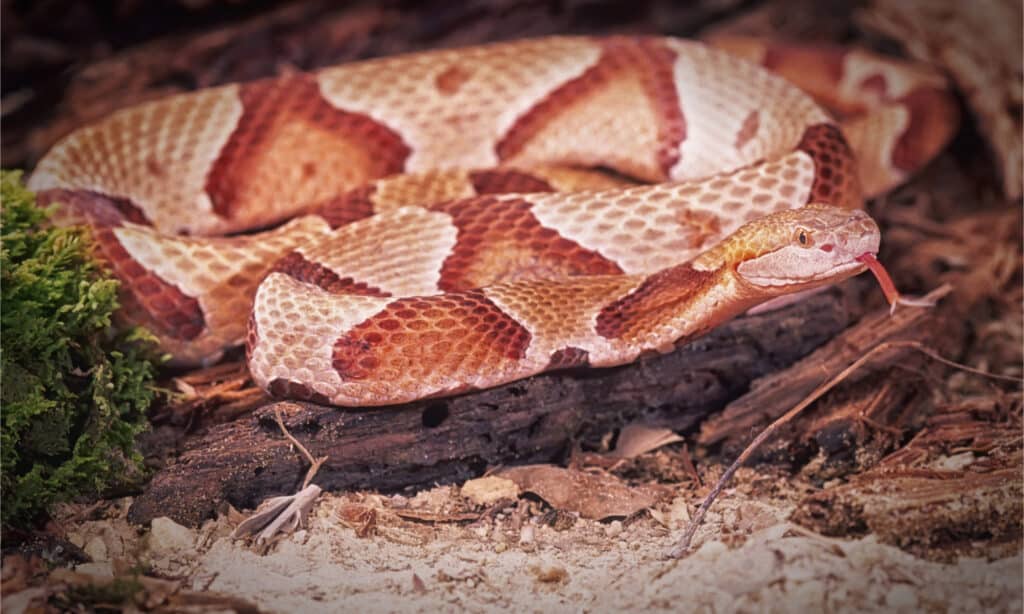
Copperheads are beautiful but venomous! Fortunately, their venom isn’t as dangerous as their cousin the cottonmouth.
©outdoorsman/Shutterstock.com
Our second competitor is the copperhead snake. Can you picture the copperhead’s triangular-shaped head? It’s slightly wider than its neck, with a captivating copper-colored crown. Its coloration ranges from light tan to coppery or reddish-brown. These snakes also have distinct hourglass-shaped markings. The pattern serves as camouflage when moving among fallen leaves and twigs.
With its adaptability, the copperhead can be found in forests, rocky areas, swamps, or near bodies of water. They have a native range in North America, from Massachusetts to Nebraska in the north and down to Texas and Florida in the south.
How do they hunt? Copperheads are ambush predators. They rely on camouflage to blend into their surroundings and surprise their prey. They have heat-sensitive pits between their eyes and nostrils. The loreal pits help them detect the body heat of warm-blooded animals, aiding in locating prey in low light or obscured conditions.
Once a copperhead captures its prey, it uses venom to immobilize and digest. The venom comes through fangs located in the front of their mouths. Copperheads have hinged fangs that fold back when not in use, and when they strike, the fangs swing forward swoosh!
Copperhead vs. Cottonmouth: Diet
Now, let’s peek at the cottonmouth vs. copperhead snake’s dietary preferences. When it comes to their diet, copperheads aren’t picky eaters.
Copperhead Diet
The nature of the copperhead’s diet can vary based on factors such as location, habitat, and seasonal availability of prey. Overall, they are known to feed on mice, rats, voles, shrews, frogs, toads, lizards, small snakes, birds, and even insects on occasion. Their age can also play a role in deciding what they eat. Juvenile copperheads usually feed on smaller prey items like insects and lizards until they grow larger.
Cottonmouth Diet
Cottonmouths eat a lot of different things. They dine on aquatic species such as fish, amphibians, birds, eggs, rodents, baby alligators, small turtles, and other snakes. This showcases their remarkable hunting abilities, no matter what animal they’re targeting.
Cottonmouths Love Eating Other Snakes
In a cottonmouth vs. copperhead battle, the cottonmouth could eat the copperhead! That doesn’t mean they would, but they could. These snakes have a reputation for eating other snakes.

In a cottonmouth vs. copperhead battle, the cottonmouth could eat the copperhead!
©KF2017/Shutterstock.com
Why eat your kind? Here are the top reasons cottonmouths eat other snakes:
Food availability: A lot of snakes are opportunistic hunters. If they come across a snake that is small enough to swallow and fits within their hunting capabilities, they will take the opportunity to feed on it.
Competition and territory: In some cases, cottonmouths may consume other snakes as a way to eliminate competition. They can reduce competition for resources like food.
Energy requirements: Like other predators, cottonmouths must meet their energy requirements to live. If they encounter a snake that they can overpower and consume, it provides them with a source of nutrition and energy.
Copperheads Love Eating Cicadas
Copperheads aren’t likely to eat a cottonmouth unless it is a baby cottonmouth. But they are likely to feast on cicadas. This species has a special relationship with these protein-packed bugs.
Cicadas, those buzzing insects known for their loud chorus during the summer, hold a unique place in the diet of copperhead snakes. When cicadas emerge from their year-long underground stay, they become a feast for hungry copperheads. These insects are not only abundant during emergencies, but they also offer a rich source of fats and proteins.
As copperheads slither through the night, they have the opportunity to indulge in these plump, protein-rich cicadas. It’s as if nature has provided them with a healthy seasonal treat! Now, with a belly full of bugs, this copperhead has all the energy it needs to start the first round of our animal battle.
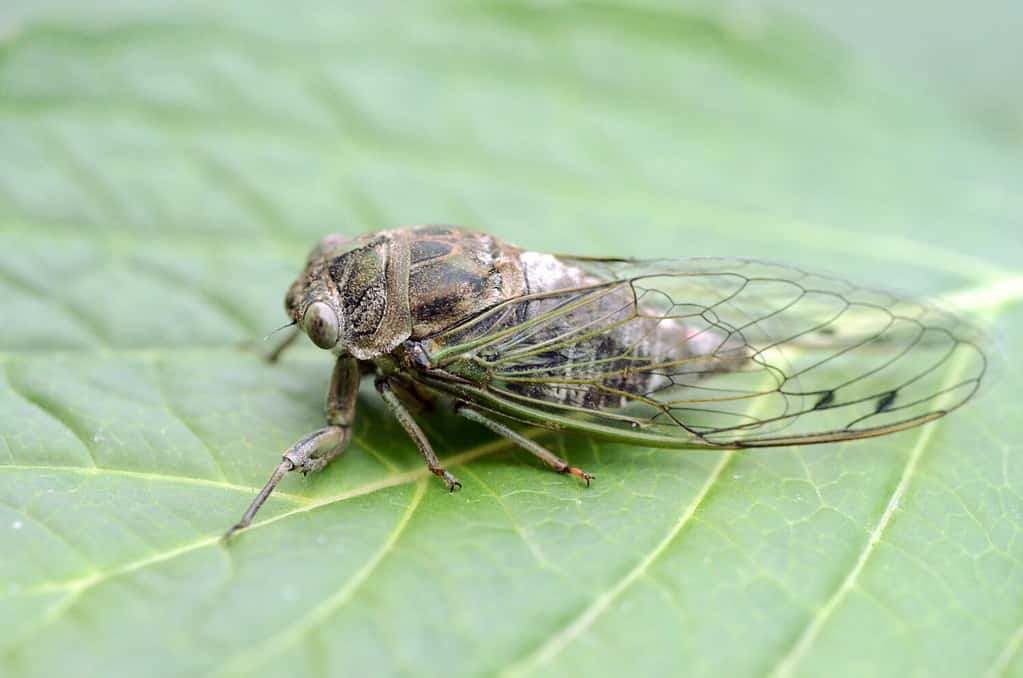
Cicadas, those buzzing insects known for their loud chorus during the summer, hold a unique place in the diet of copperhead snakes.
©Akvals/Shutterstock.com
Round One: Venom
Round one is all about snake venom! Fun fact; all snakes are either venomous or non-venomous, but they’re not poisonous. Sometimes people use poison and venom interchangeably, which can lead to confusion. For this animal showdown, we’re dealing with two venomous snakes.
When it comes to venom potency, the cottonmouth snake takes the spotlight. Its venom is widely recognized for its potency and the potential risks associated with envenomation. In 2017 alone, there were reported 255 cottonmouth envenomations in the U.S. Out of those cases, 10 had serious outcomes, although fortunately, no deaths were reported. The effects of cottonmouth venom can be severe and require prompt medical attention.
Now, let’s turn our attention to the copperhead snake, a member of the same family as the cottonmouth. While copperheads are less venomous than their counterpart, some controversy exists. There’s controversy surrounding the necessity of anti-venom treatment for copperhead bites.
Interestingly, data from copperhead bites suggest that the effects of their venom typically resolve within 7 to 13 days. Despite this timeframe, there is an ongoing debate. The debate centers around the appropriate course of treatment for copperhead bites. Some believe you need anti-venom; others argue it’s unnecessary.
Copperhead bites may not be as immediately threatening as those from a cottonmouth. However, victims often require medical attention. The medical care may include observation, local wound care, and limb elevation. And in some cases, potential anti-venom administration.
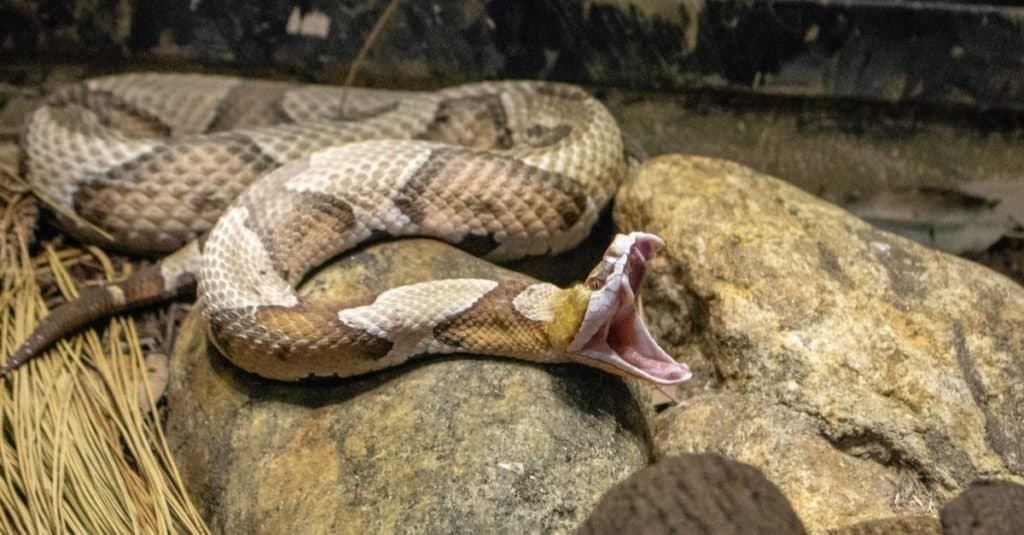
Copperhead bites may not be as immediately threatening as those from a cottonmouth. However, victims often require medical attention.
©Suzanna Ruby/Shutterstock.com
Snake Bite Identification Study
Imagine getting bit by a snake but now knowing the species. Now, that would be a problem! As scary as it sounds, it does happen, especially in the case of copperhead vs. cottonmouth bites.
To learn more about the potential misidentification, a snake bite study took place in the southern United States. They reviewed incidents where snakebite victims brought the deceased snake or provided photographs of the snake to the hospital.
In the study, all copperheads were correctly identified by callers seeking help. But the results took a surprising turn when it came to cottonmouths.
Astonishingly, only 21% of cottonmouths were correctly identified. And a whopping 74% were mistaken for copperheads. This study serves as a valuable reminder of the importance of honing our snake identification skills. Here’s a cheat sheet for identifying copperheads.
Round Two Size
Alright, animal lovers, let’s get ready for round two of our thrilling cottonmouth vs. copperhead snake showdown. This round is all about comparing snake size. Let’s start with the Cottonmouth, a heavyweight in the size category.
Cottonmouths can grow to impressive lengths, averaging between 3 to 4 feet! But hold onto your hats because record-setting specimens have stretched to nearly 6 feet. Imagine what it’d be like seeing a 6-foot venomous snake slither by. Yikes!
Now, for the copperhead, our smaller but no less fascinating contender. These cunning snakes typically measure 2 to 3 feet in length, showcasing a more modest size than their cottonmouth counterpart. However, there’s always room for surprises, as some larger copperheads have been known to reach up to 4.5 feet in length.
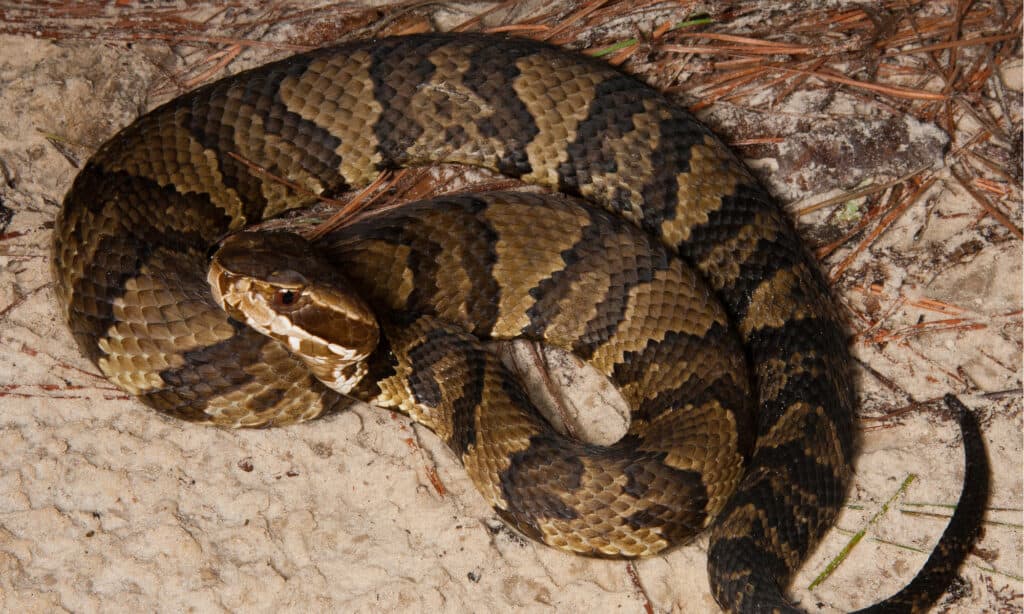
Cottonmouths can grow to impressive lengths, averaging between 3 to 4 feet!
©Nathan A Shepard/Shutterstock.com
What Determines Their Size?
If one of our competitors is a female, she’ll have an instant advantage. When it comes to copperhead and cottonmouth snakes, females usually take the crown in terms of size. This phenomenon, known as sexual dimorphism, is a common characteristic in many snake species.
Lifelong Growth
Many snake species, including the cottonmouth, and copperhead, continue growing throughout their lives. While the growth rate slows as they age, it never stops. This perpetual growth adds to the impressive nature of these serpents.
Environmental Impact on Size
The environment plays a role in determining the size of these snakes. In warmer climates, where metabolic rates are higher, and food availability is abundant, snakes have the potential to grow larger. So, the temperature of their habitat can influence their overall dimensions.
Don’t Forget Body Proportions
Size isn’t the only factor to consider; the proportions of a snake’s body are also essential. The cottonmouth and copperhead boast robust and heavy bodies concerning their length. This physique contributes to their hunting prowess and overall survival strategies.
Size and Venom
Larger snakes have the potential to deliver a higher quantity of venom, but size doesn’t necessarily correlate with venom potency. Both cottonmouths and copperheads, regardless of their size, possess venom that is potent enough to warrant medical attention in the event of a bite. And while these snakes are immune to their venom, they’re not immune to each other.
Round Three: Reputation and History
The last round is here! It’s round three of our thrilling snake showdown. For this final round, we’ll explore reputation, history, and symbolism.
Let’s dive into the intriguing world of the cottonmouth first. While they are often depicted as nature’s bullies, ready to strike immediately, the truth is that cottonmouths usually only bite when provoked. Snakes aren’t aggressive; they’re defensive. Their defense tactics have fueled their reputation, but thankfully today, the science behind the species is finally coming to light.
Throughout history, cottonmouth snakes have been symbols of fear and danger. Their venomous nature and defensive behavior made them subjects of both cautionary tales and misguided fear. In earlier periods of American history, cottonmouths likely made headlines with their venomous bites, contributing to their infamous reputation. They were the boogeyman of the snake work, but thankfully that’s all starting to change now. As new science comes out about the species, we realize they want to be left alone.
Transitioning to the copperhead, our attention turns to their more complex reputation. Copperheads are known for their tendency to freeze and blend in with their surroundings rather than confront threats. Despite their shy demeanor, they are responsible for more bites than any other venomous snake in the United States. This unique combination of shyness and deadliness has earned them a reputation as silent assassins. But it’s a misconception. Again, copperheads don’t want to bite people, but they will defend themselves.
Snake Symbolism
Copperheads often represent stealth and surprise. Their remarkable camouflage ability allows them to blend seamlessly into their environment, and their unexpected bites remind us of the surprises nature can spring upon us. It’s a testament to their survival strategies and their ability to thrive in diverse habitats.
Cottonmouths can symbolize power and strength. Depending on the context, these snakes can be a powerful reminder of what nature’s capable of.

Copperheads often represent stealth and surprise. Their remarkable camouflage ability allows them to blend seamlessly into their environment.
©JacobLoyacano/Shutterstock.com
Who Wins?
We are thrilled to announce that we have a tie! The cottonmouth vs. copperhead showdown highlights the strengths of each species. After reviewing the size, venom, dietary needs, and more, we can conclude they’re worthy adversaries. Each snake can hold its own and work hard to survive in an animal matchup.
Both the cottonmouth and the copperhead can thrive in dense forest habitats. Their size, agility, and ability help them blend seamlessly into their surroundings. This makes them formidable predators in their unique ecosystem.
While the cottonmouth possesses potent venom, let’s not underestimate the venom of the copperhead. Each snake’s venom is unique. They’re customized and tuned to suit their specific hunting strategies and prey. This ensures effectiveness in capturing and subduing its targets. And while the cottonmouth is immune to its venom, it’s not immune to the copperheads.
The copperhead’s exceptional camouflage allows it to patiently lie in wait, striking with precision when prey comes within reach. Simultaneously, the cottonmouth’s semi-aquatic nature near water sources provides it with a strategic position to ambush unsuspecting prey. Both snakes have honed their ambush techniques to perfection.
Finally, we had to make this a tie because each species is great, evading threats and taking down prey. When it comes to defending themselves, both competitors know how to brawl. The copperhead’s motionless behavior and warning coloration serve as a deterrent, while the cottonmouth’s wide-mouthed display can intimidate potential predators, showcasing their willingness to strike! With two snakes as impressive as these, it’s no wonder they wound up in a tie.
The photo featured at the top of this post is ©
Discover the "Monster" Snake 5X Bigger than an Anaconda
Every day A-Z Animals sends out some of the most incredible facts in the world from our free newsletter. Want to discover the 10 most beautiful snakes in the world, a "snake island" where you're never more than 3 feet from danger, or a "monster" snake 5X larger than an anaconda? Then sign up right now and you'll start receiving our daily newsletter absolutely free.
Thank you for reading! Have some feedback for us? Contact the AZ Animals editorial team.







